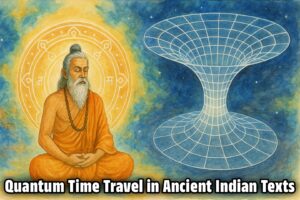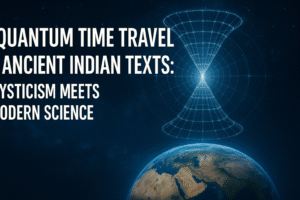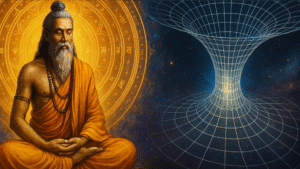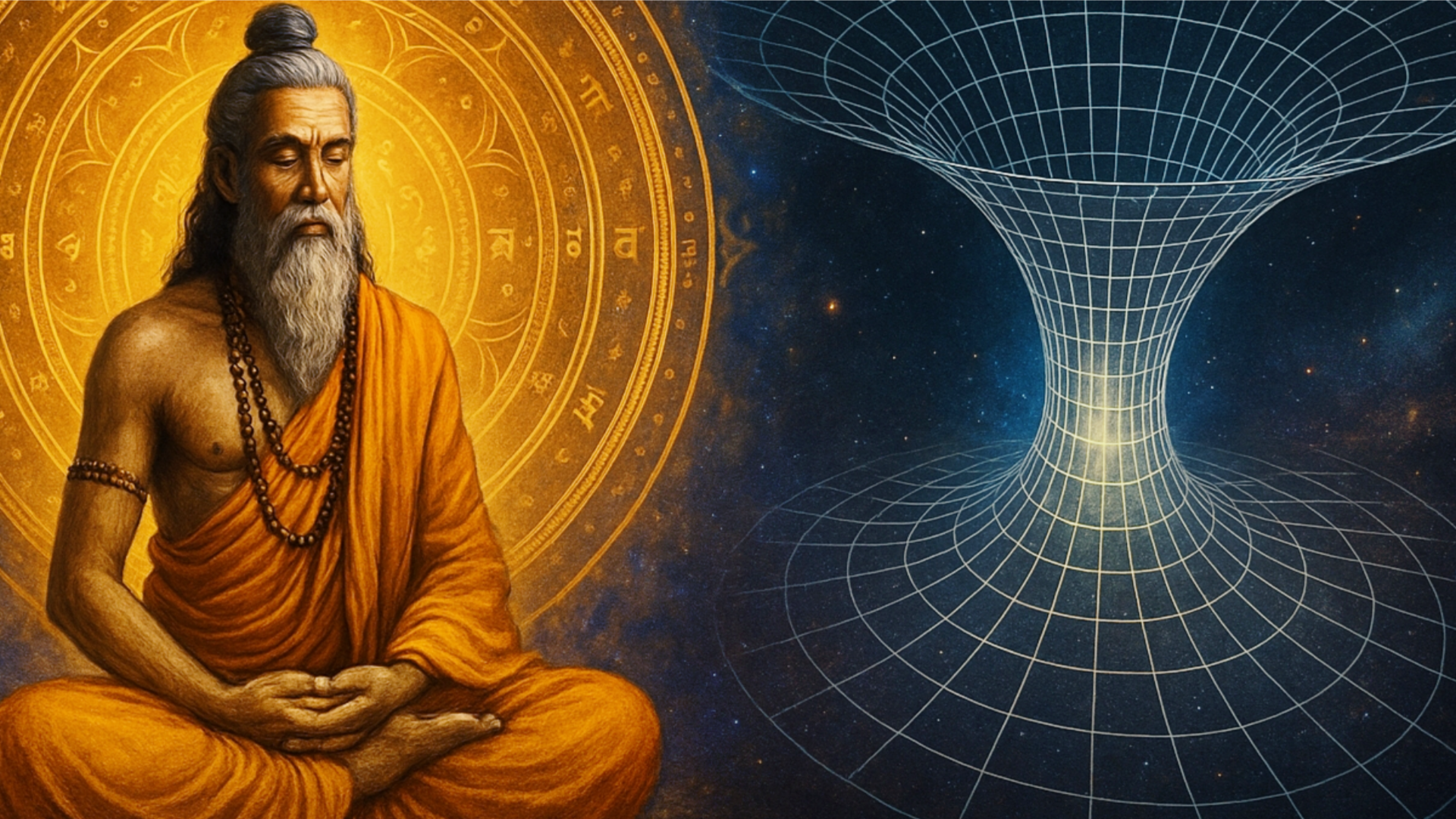
Quantum Time Travel in Ancient Indian Texts
Did Ancient Indian Texts Predict Quantum Time Travel?
Time travel, a captivating concept often associated with science fiction, finds unexpected echoes in the sacred texts of ancient India. With the rise of quantum physics, modern science is beginning to scratch the surface of ideas that seem to parallel what ancient rishis (sages) spoke about thousands of years ago. Could it be that Indian scriptures like the Mahabharata, Bhagavata Purana, and Yoga Vasistha contain allegorical descriptions of quantum time travel?
In this article, we explore the fascinating intersections between quantum mechanics, relativity, and ancient Indian time travel narratives.
Time Dilation and Quantum Time Travel: A Modern Perspective
Before diving into ancient texts, it’s important to understand the science:
Time Dilation (as per Einstein’s theory of relativity): Time slows down when an object moves closer to the speed of light or is near a strong gravitational field.
Quantum Physics: Talks about particles existing in multiple states (superposition), teleportation (quantum entanglement), and the probability of parallel timelines.
Multiverse Theory: The possibility that multiple realities and timelines exist simultaneously.
These concepts, though groundbreaking in modern physics, have uncanny counterparts in ancient Indian thought.
Table of Contents

Time Travel References in Ancient Indian Scriptures
- The Story of King Kakudmi and Revati – Brahmanda Purana & Bhagavata Purana
King Kakudmi and his daughter Revati travel to the abode of Brahma to seek advice about a suitable husband. When they return to Earth, they find that millions of years have passed, and all of their contemporaries are long gone.
Scientific Parallel: This is a classic example of time dilation — akin to what happens when astronauts travel at near-light speeds.
- The Mahabharata – Ashtavakra and Time Perception
The sage Ashtavakra teaches King Janaka that time and space are illusions — constructs of the human mind. Similarly, the warrior prince Arjuna, during the Vishwaroopa Darshan, sees all of creation compressed in a single moment.
Quantum Connection: The non-linearity of time and consciousness collapsing reality mirror ideas in quantum physics and the observer effect.
- Yoga Vasistha – The Tale of Lila
In this philosophical text, Queen Lila travels between multiple universes and experiences different timelines, realizing that each moment can contain entire lifetimes.
Scientific Echo: This narrative resonates with the multiverse theory and quantum superposition, where reality splits into different branches with each decision.
- Lord Krishna and Simultaneity
Lord Krishna is described as being present in multiple places simultaneously, guiding different events. This hints at a being that exists outside of linear time.
Quantum Parallel: This could symbolize quantum entanglement, where one particle can instantaneously influence another, regardless of distance.

Ancient Rishis: The First Quantum Thinkers?
The Rishis of India believed in:
Kalachakra (The Wheel of Time): A cyclic view of time, as opposed to a linear one.
Trikala Darshi (Knower of Past, Present, Future): Indicative of beings who perceive time as one continuum.
Turiya State: A fourth dimension of consciousness beyond waking, dreaming, and sleep — possibly analogous to accessing higher dimensions of reality.
Their meditative practices may have unlocked experiences that modern science is only now beginning to understand through theoretical physics.
Are These Metaphors or Scientific Truths?
Skeptics argue these are poetic metaphors. However, with growing research into quantum consciousness and space-time anomalies, these ancient stories are gaining a fresh perspective.
Modern physicists like Michio Kaku, Stephen Hawking, and Roger Penrose have speculated about the bending of space-time, wormholes, and alternate realities — concepts deeply embedded in ancient Indian cosmology.
Conclusion
While definitive proof of quantum time travel in ancient India may remain elusive, the parallels between ancient Vedic wisdom and cutting-edge physics are too striking to ignore. Whether you view them as spiritual metaphors or hidden scientific knowledge, these ancient texts invite us to rethink time, consciousness, and the universe itself.

Frequently asked questions (FAQs) on Quantum Time Travel in Ancient Indian Texts:
- What is quantum time travel?
Quantum time travel refers to theoretical concepts in quantum physics where particles or consciousness could move through time via quantum phenomena like entanglement, wormholes, or parallel timelines.
- Are there stories of time travel in ancient Indian scriptures?
Yes, several stories in ancient Indian texts describe time dilation and alternate realities, such as the tale of King Kakudmi and Revati, Queen Lila in Yoga Vasistha, and Brahma’s time scale, which resemble modern concepts of time travel.
- What is the story of King Kakudmi and Revati?
King Kakudmi and his daughter Revati visit Lord Brahma and spend a short time there. Upon returning to Earth, millions of years have passed, showing a clear example of time dilation, similar to Einstein’s relativity theory.
- Is time travel scientifically proven?
No, time travel is not yet proven. However, theories in Einstein’s relativity and quantum mechanics suggest that under certain conditions — like traveling near the speed of light — time could slow down relative to others.
- Do the Vedas or Upanishads mention time travel?
While the Vedas and Upanishads don’t directly mention “time travel,” they describe cyclical time (Kalachakra), multiple dimensions, and timeless states of consciousness, which can be interpreted as forms of spiritual or metaphysical time travel.
- How does Yoga Vasistha relate to quantum time concepts?
In Yoga Vasistha, the story of Queen Lila explores multiple timelines, parallel worlds, and subjective experiences of time, which resemble modern ideas in multiverse theory and quantum superposition.
- What does “Kalachakra” mean in Hindu philosophy?
Kalachakra, or the “Wheel of Time,” is a concept in Indian cosmology where time is cyclical, infinite, and relative — very similar to certain non-linear models of time in modern cosmology and quantum theory.
- Was Lord Krishna a time traveler?
Lord Krishna is described as being present in multiple places and timelines simultaneously. Though not called a “time traveler,” his actions reflect transcendence over time and space, a trait akin to quantum omnipresence.
- Do ancient Indian texts support multiverse theory?
Yes, many texts like Yoga Vasistha, Bhagavata Purana, and Devi Bhagavatam mention countless universes (Ananta Koti Brahmanda) — an idea very similar to the multiverse in quantum physics.
- Can meditation lead to time perception changes as per ancient texts?
Yes, sages in Indian texts describe entering states where centuries pass outside while only moments pass within meditation. These experiences may be spiritual analogs to time dilation, suggesting deep links between consciousness and time.
Summary: Quantum Time Travel in Ancient Indian Texts
Ancient Indian scriptures like the Bhagavata Purana, Yoga Vasistha, and Mahabharata contain fascinating narratives that align with modern quantum physics and time travel theories. Stories such as King Kakudmi’s journey to Brahmaloka, where time on Earth speeds up drastically, and Queen Lila’s exploration of multiple realities, hint at advanced understandings of time dilation, multiverse theory, and non-linear time.
While modern science explores concepts like wormholes, parallel universes, and quantum entanglement, Indian sages had already spoken about Kalachakra (cyclical time) and higher states of consciousness that transcend time. These texts may not use scientific terminology, but their philosophical depth and symbolic stories suggest a surprisingly sophisticated grasp of the nature of space-time and reality.
In essence, ancient Indian wisdom offers a spiritual perspective that intriguingly parallels today’s cutting-edge quantum theories—inviting a deeper exploration of time, consciousness, and the universe.
Unlock the Ancient Wisdom of Sanatan Dharma – Join Us on YouTube!
👉 Subscribe now to Prachin Sanatan Dharma and embark on a journey of enlightenment.
Explore timeless teachings, spiritual insights, and cultural richness on our YouTube channel, Prachin Sanatan Dharma. Dive deep into the essence of Sanatan Dharma through captivating videos that inspire and educate.
Related Articles
- Restful Nights: Ayurvedic Remedies and Traditional Indian Practices to Overcome Insomnia and Late-Night Habits
- The Tridevi: Lakshmi, Saraswati, and Parvati – Their Roles and Powers
- “Divine Creatures of Ancient Indian Scriptures: Exploring the Role of Animals in the Vedas, Puranas, and Mahabharata”
- Nature and Spirituality: Exploring the Sacred Essence of the Himalayas, Ganga, and Other Natural Wonders”
- “Reviving the Gurukul System: Relevance and Lessons for Modern Education”
- “Exploring Greek and Indian Mythology: Similarities Between Greek and Indian Mythology “
- “Embracing Sattvic Living: Harmonizing Mind, Body, and Soul Through Food and Lifestyle”
- “Charity and Prosperity: Exploring the Concept of Daan and Its Financial Relevance in Modern Life”
- How to Build an Eco-Friendly Home Inspired by Vastu Shastra
- Comparison of Ancient and Modern Sports: How Traditional Sports Have Influenced Contemporary Games
- “Timeless Lessons from Ancient Tales: Linking Samudra Manthan and Ganga’s Descent to Modern Ecological Challenges”
- “Reviving Sanskrit: How AI is Preserving Ancient Languages for the Future”
- “Mathura: The Sacred Land of Lord Krishna’s Divine Leelas”
- Investing for Future Generations: Lessons from Indian Traditions on Legacy Building and Wealth Preservation
- “Ancient Indian Wisdom: Timeless Lessons for Tackling Today’s Climate Crisis”
- “Artificial Intelligence and Spirituality: Transforming Ancient Practices for the Modern World”
- “Gold and Real Estate in India: Timeless Assets Shaping Financial Strategies”
- Tradition Meets Innovation: The Evolution of Technology in Hindu Rituals
- End-of-World Myths: Exploring Kali Yuga in Hinduism and Ragnarök in Norse Mythology
- Garuda, Pegasus, and Dragons: The Universal Ties of Mythical Beasts Across Cultures
- “Ancient Vimanas: Mythical Flying Machines or Evidence of Advanced Technology?”
- Time Travel in Hindu Mythology: The Fascinating Tales of Kakudmi and King Raivata
- “Divine Feminine Power in Hindu Mythology: The Legends of Durga, Saraswati, and Lakshmi”
- “Divine Beings of Sanatan Dharma: The Spiritual Significance of Sacred Animals in Hinduism”
- “Symbolism in Mythological Art: Unlocking Hidden Meanings in Ancient Temple Carvings”
- “Exploring Technological Advancements in Ancient India and Civilizations: Vimana, Metallurgy, & Water Management systems”
- Unveiling the Mysteries: Ancient Temples of Sanatan Dharma , Mysterious Temples of India
- “The Scientific Knowledge of Sanatan Dharma: Ancient Wisdom Meets Modern Science”
- Ancient Indian Sports and Games: Celebrating a Legacy of Skill, Strength & Strategy”
- “Exploring the Cosmic Link: The Connection Between Astronomy and Vedic Astrology”
- The Power of Sanskrit: Unlocking the Divine Language of the Gods
- “The End of Kaliyuga: A Sanatan Insight into the World’s Final Chapter”
- Explore more articles on Prachin Sanatan Yuga.
Quantum Time Travel in Ancient Indian Texts: Mysticism Meets Modern Science Quantum Time Travel in Ancient Indian Texts: Mysticism Meets Modern Science Quantum Time Travel in Ancient Indian Texts: Mysticism Meets Modern Science Quantum Time Travel in Ancient Indian Texts: Mysticism Meets Modern Science Quantum Time Travel in Ancient Indian Texts: Mysticism Meets Modern Science
Quantum Time Travel in Ancient Indian Texts: Mysticism Meets Modern Science Quantum Time Travel in Ancient Indian Texts: Mysticism Meets Modern Science Quantum Time Travel in Ancient Indian Texts: Mysticism Meets Modern Science Quantum Time Travel in Ancient Indian Texts: Mysticism Meets Modern Science Quantum Time Travel in Ancient Indian Texts: Mysticism Meets Modern Science
Quantum Time Travel in Ancient Indian Texts: Mysticism Meets Modern Science Quantum Time Travel in Ancient Indian Texts: Mysticism Meets Modern Science Quantum Time Travel in Ancient Indian Texts: Mysticism Meets Modern Science Quantum Time Travel in Ancient Indian Texts: Mysticism Meets Modern Science Quantum Time Travel in Ancient Indian Texts: Mysticism Meets Modern Science
